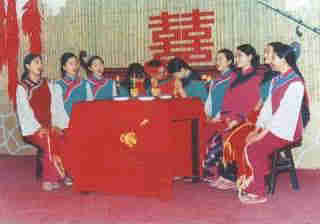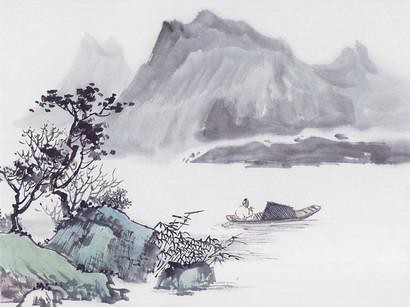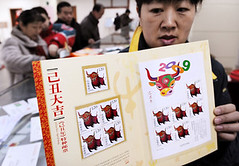| Home > Living in China > Custom |
The Tujia Ethnic Group Cry Marriage
Ten girls include the bride in the middle are crying on the eve of wedding day.

Crying marriage is a matrimonial custom that must be observed by every Tujia girl, whether she is satisfied with the bridegroom or not. Some brides begin to cry as early as two months ahead of the marriage, while others cry for at least ten days or half a month beforehand.
First, the bride cries with her mother, then with her sister-in-law. After that, the neighbors and other single women come to cry with her, all of them sitting on the bed. While the bride and one of the accompaniers cry aloud, the others weep by the side. The bride cry for her parents and siblings as well as for the relatives and friends, mainly telling her life experience and her sorrow at leaving her loved ones while also expressing her gratitude towards her parents for bringing her up. The women also scold the matchmaker, and encourage the bride.
Although usually there are fixed crying songs, the bride may improvise sometimes. Tujia people attach significant importance to the custom of crying marriage. For a Tujia girl, whether she can cry and how she cries will usually cast great influence over her identity and reputation, and have been considered as symbols of the girl's wisdom and morals.
Some girls begin to learn crying at a young age, and some parents even go so far as inviting an elderly woman to teach their daughters how to cry. When they are fifteen or sixteen years old, the girls will practice crying with their young companions, and sometimes teach each other how to cry.
According to Tujia custom, there are two ways of crying: The first way is for the bride to cry alone, and the second way is for ten girls, including the bride, to cry together. On the eve of the wedding day, the bride's parents usually invite nine single women to join the process.Two girls start the process with a poem or a song, which is followed by songs from the other companions. Most of the songs are themed on filial piety, diligence and etiquette, and the process lasts until dawn.
Art
 more
moreShadow Play still Popular in Some
Shadow play, a traditional Chinese folk art with a history of more

Origin and Tools of Ink & Wash
Ink and wash painting is an East Asian type of brush painting, also

China Issued Special Stamps for
Citizens in Nanjing, East of China's Jiangsu Province, queued

Customs
 more
moreChinese Kungfu
Origin and Development of Wudang Martial Arts
According to the legend, Zhang Sanfeng is the originator of the
Introduction to Wudang Mountains
The Wudang Mountains, also known as Wu Tang Shan or simply Wudang,
Everybody was kungfu fighting
Niels Tsai, a kungfu enthusiast from Malaysia, was halfway up misty




 print
print  email
email  Favorite
Favorite  Transtlate
Transtlate 